Soldiers' Tower Virtual Tour
 The Soldiers’ Tower is a world-renowned memorial to the 1181 members of the University who gave their lives in the cause of peace and freedom during the two World Wars.
The Soldiers’ Tower is a world-renowned memorial to the 1181 members of the University who gave their lives in the cause of peace and freedom during the two World Wars.
In January, 1919 the Alumni Federation (University of Toronto Alumni Association) appealed for funds to build a War Memorial and establish scholarships in memory of those students, staff and alumni who served in the Great War. The appeal raised $397,141. The Tower was completed in 1924 at a cost of $252,500 which included the Memorial Screen, but not the clock and the carillon which were added in 1927. The surplus is still in use for scholarships to this day. The Architects were Henry Sproatt & Earnest R. Rolph.
Levels to Visit
The Soldiers' Tower has four stories or levels that can be visited:
- The top or fourth level houses the bells of the carillon
- The Memorial Room is on the second level and is reached through a door to the east of the tower proper on the south side.
Take this route.
It is discussed under the following headings:
The Staircase of Honour
The Memorial Window
West Wall, "Great Canadians in Peace and War"
East Wall, "U. of T. during the Wars"
The Medal Cabinet
The Memorial Books
Other Displays
- The ground level includes: The Memorial Screen on which is carved the names of those lost in the Great War, 1914-1918; The Memorial Archway which lists those lost in the Second World War, 1939-1945; The Garden of Remembrance; and the area in front of the tower where the annual service of remembrance is normally held. Look at ground level features.
The Carillon and the Clock
The top levels, where the Carillon and the Clock are situated, are reached through a door on the west side of the Tower. From the south go though the arch on the west side of the tower to find the door. Usually after carillon recitals the carilloneur will open the door and conduct those interested up a 111 step spiral staircase. The playing clavier and practice console are in the Clock Room on the tower’s third level. To reach them, you enter by a door in the southwest corner of the tower and climb a 111 step circular staircase. There is staircase from that level to the fourth level where the bells are.


The Carillon
 The Soldiers’ Tower Carillon, the gift of graduates, was dedicated October 6, 1927, in memory of those members of this University who gave their lives in the Great War. Originally there were 23 bells, the minimum number for a carillon. These original bells were cast by the British firm, Gillett and Johnston, which also cast the bells of the carillon in the Peace Tower at Ottawa. Dedications for these bells are inscribed on stone panels high on the walls of the Memorial Room, starting with number I, the Bourdon, the largest and deepest bell. The wording for the dedications may be found here.In 1952, 19 new bells were donated in memory of the members of the University who fell in the Second World War and to enlarge the existing instrument. Unfortunately these bells did not match the tone of the original ones so funds were raised to purchase 28 Petit and Fritsen bells, a new playing clavier, and a practice console. The augmented, 51-bell, Soldiers Tower Carillon was rededicated on May 7, 1976.The playing clavier and practice console are in the Clock Room on the tower’s third level.
The Soldiers’ Tower Carillon, the gift of graduates, was dedicated October 6, 1927, in memory of those members of this University who gave their lives in the Great War. Originally there were 23 bells, the minimum number for a carillon. These original bells were cast by the British firm, Gillett and Johnston, which also cast the bells of the carillon in the Peace Tower at Ottawa. Dedications for these bells are inscribed on stone panels high on the walls of the Memorial Room, starting with number I, the Bourdon, the largest and deepest bell. The wording for the dedications may be found here.In 1952, 19 new bells were donated in memory of the members of the University who fell in the Second World War and to enlarge the existing instrument. Unfortunately these bells did not match the tone of the original ones so funds were raised to purchase 28 Petit and Fritsen bells, a new playing clavier, and a practice console. The augmented, 51-bell, Soldiers Tower Carillon was rededicated on May 7, 1976.The playing clavier and practice console are in the Clock Room on the tower’s third level. 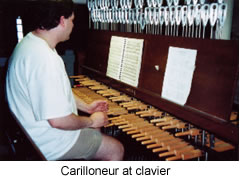 The carillon, as a musical instrument, originated in the Low Countries. It consists of at least 23 tuned bronze bells hung in a stationary position. The sound is created by cast iron clappers connected by wires to a keyboard called the clavier. The clavier has a double row of rounded wooden levers arranged like the keys of a piano. There is also a pedal board which plays the lowest two octaves. Soldiers’ Tower Carillon is the only university carillon in Canada. Its 51 bells, which range in weight from four tons (the Bourdon) to 23 pounds, are hung on a four-tier frame in the top level of the tower.
The carillon, as a musical instrument, originated in the Low Countries. It consists of at least 23 tuned bronze bells hung in a stationary position. The sound is created by cast iron clappers connected by wires to a keyboard called the clavier. The clavier has a double row of rounded wooden levers arranged like the keys of a piano. There is also a pedal board which plays the lowest two octaves. Soldiers’ Tower Carillon is the only university carillon in Canada. Its 51 bells, which range in weight from four tons (the Bourdon) to 23 pounds, are hung on a four-tier frame in the top level of the tower. The Soldiers’ Tower Carillon is played on special occasions such as Convocations, Spring Reunion, Fall Homecoming and Remembrance Day. Occasionally a special series of recitals is offered. The best places to listen to the carillon are Hart House Circle lawn, the back campus, and Hart House and University College quadrangles. Following many recitals, the tower is open for public viewing and a demonstration. Meet at the base of the tower on the west side.
The Soldiers’ Tower Carillon is played on special occasions such as Convocations, Spring Reunion, Fall Homecoming and Remembrance Day. Occasionally a special series of recitals is offered. The best places to listen to the carillon are Hart House Circle lawn, the back campus, and Hart House and University College quadrangles. Following many recitals, the tower is open for public viewing and a demonstration. Meet at the base of the tower on the west side. For more about the carillon as an instrument go to the The Guild of Carillonneurs in North America (GCNA) site . There is also another page on the U of T website that tells about The University of Toronto Carillon
. There is also another page on the U of T website that tells about The University of Toronto Carillon
.
The Clock
The clock was purchased in 1927, by the University of Toronto Alumni Association from the British firm, Gillett and Johnston together with the original 23 bells of the carillon.
Return to start of Virtual Tour
Dedication Inscriptions for the Original Twenty Three Bells
as carved on the walls of the Memorial Room
- The gift of H. Maurice Cody, BA'20, in memory of the Old Boys of University of Toronto Schools.
- To honour the memory of Lieut. Gordon S.M. Gauld, MC, RFA and RFC, BA'15 UC, killed while flying March 25, 1918.
- Class of 1882 University College
- In memory of Capt. Howard Kilbourne Harris, MC, Essex Regiment, killed in action between Mourchies and Peronne, February 22, 1918.
- In memory of members of the 147th (Grey) Battalion, C.E.F.
- Dedicated to the memory of Col. W.R. Lang, VD, by the University of Toronto Contingent, COTC
- In memory of Maj. Gordon H. Southam, BA'07 UC, killed in action, Oct. 15, 1916 at Courcelette
- Lt. James Ernest Robertson, BA, LL.B, 27th Can.Bn., killed in action, March 9, 1916 "VIRTUTIS GLORIA MERCES"
- Presented by W.H. Ballard, MA, LL.D, UC 1871, in memory of the old University Company K (No.9) Queen's Own Rifles
- Montreal Branch, Alumni Federation
- University College Alumnae Association
- University of Toronto Club of New York City
- A tribute from the officers of No.4 Canadian General Hospital to the memory of their comrades who fell
- In memory of the members of Delta Kappa Epsilon who gave their lives in the Great war 1914-1918
- Alpha Delta Phi
- Delta Upsilon
- In memory of Lt. Evan Ryrie, UC'16 "I have lived my life and that which I have done may He within Himself make pure"
- The gift of Canadian Army Women's Auxiliary in proud remembrance of the members of the Corps who fell in defence of the Empire
- Fifty-one men of Trinity
- From the Academy of Medicine, Toronto, as a tribute to the memory of the Fellows who gave their lives
- "Extol, ye bell, the virtue of our valorous men." Alumni - Faculty of Applied Science and Engineering
- The Alumni Association and friends of Victoria College
- University College Alumni Association
Bells XXIV-XLII were the gift of Eric Phillips, CBE,DSO,MC,BASc,LL.D, Chairman of the Board of Governors, in memory of the members of the University who fell in the Second World War June 5, 1953. The Soldiers' Tower Carillon was completed by the addition of twenty eight new bells and rededicated on May 7th, 1976.
Return to start of Virtual Tour
The Memorial Room
As we approach the Tower from the south, the door to The Memorial Room is to the right. The Memorial Room is a small museum housing mementoes of the wartime service of students, staff and alumni, including: medals, memorial books, portraits, photographs, flags and colours. It is located on the second level of the tower and is reached through a doorway to the east of the tower. Much of the credit for these displays is due to Major Roy Oglesby, Chair of the Soldiers’ Tower Committee from 1979 to 1986, and still active as Curator of the Memorial Room. The focus is on the wartime service of U. of T. people rather than on the weapons of war. The University and the Alumni want to remember with gratitude the large number of volunteers from this University who paid the supreme sacrifice in two world wars. They had many motives for volunteering, but all were willing to give up their lives for that which they valued more than life itself.
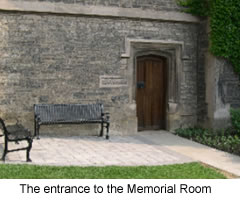
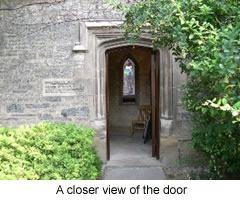
When the Memorial Room is open to the public a sign saying so is placed at the end of the walk as seen here, Enter the door and climb the stairs. Note the stone to the left of the door commemorating the dedication of the tower in 1924.
The Staircase of Honour
On entering the door, one sees ahead the first of eight new stained glass windows commissioned by the Soldiers’ Tower Committee in 2005. These windows, which honour Canadian forces in action during wartime, were designed and installed by Goodman Zissoff Stained Glass Studio, Kelowna, BC, in May 2005. The Honourable James K. Bartleman, Lieutenant Governor of Ontario, officially dedicated the new stained glass windows on May 26, 2005, an event attended by 250 alumni, donors and friends.
The men and women depicted in these windows have the rank of private or equivalent, and are shown in an appropriate wartime activity. While, with one exception, they are in the uniform of their service, as worn in the Second World War, these windows recognize all those who served in both world wars.
The three stained glass windows along the first flight of stairs, on the north wall, commemorate the women’s services.
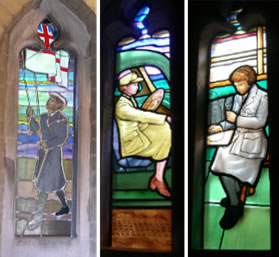 The first, a gift of the Wren Association of Toronto in memory of Mary Sweeny, shows a Wren (a member of the Women’s Royal Canadian Naval Service) raising the Royal Canadian Navy ensign.
The first, a gift of the Wren Association of Toronto in memory of Mary Sweeny, shows a Wren (a member of the Women’s Royal Canadian Naval Service) raising the Royal Canadian Navy ensign.
As one climbs the stairs, one passes next a portrayal of a CWAC, or member of the Canadian Women's Army Corps, at the wheel of a vehicle. This window is a gift of Major General Bruce Jarvis Legge, 4T1.
The third one reached before the landing, shows a radio operator in the Royal Canadian Air Force (Women's Division).
Turning and mounting the next flight, one passes three larger windows in the south wall honouring all those who served in the forces during both word wars, but these are better viewed from the landing or the final flight of stairs.
The eastern window, a gift of Major Roy B. Oglesby, depicts a Private soldier, wearing a steel helmet with his  hands on rifle reversed, and pays tribute to the fallen, who are portrayed in ghostly images on the right. In the background looms the impressive Vimy Memorial that commemorates Canada's role in the Great War.
hands on rifle reversed, and pays tribute to the fallen, who are portrayed in ghostly images on the right. In the background looms the impressive Vimy Memorial that commemorates Canada's role in the Great War.
In the middle window, a gift of Lieutenant(N) Owen S. Williams 5T0, we witness Able Seamen in the Royal Canadian Navy making a rescue at sea during the Battle of the Atlantic.
The western window depicts ground crew of the Royal Canadian Air Force, servicing an aircraft. Note that one of these men is shown as a member of a First Nation. The contributions of First Nation men and of other men of colour, was very significant in both wars.
 Ascending the third and final flight of stairs, we note in the north wall on our right two more small windows. The first one honouring volunteers in the Canadian Merchant Navy, is the gift of John Waddington and family in Yorkshire, England.
Ascending the third and final flight of stairs, we note in the north wall on our right two more small windows. The first one honouring volunteers in the Canadian Merchant Navy, is the gift of John Waddington and family in Yorkshire, England.
The topmost window honours the Auxiliary Services of The Royal Canadian Legion, the Canadian Red Cross, the Knights of Columbus, The Salvation Army and the Young Men’s Christian Association, all of which brought support and comfort to the men and women in the forces. Each service is represented by its emblem as used during the Second World War.
Continue on up the stairs and enter the Memorial Room.
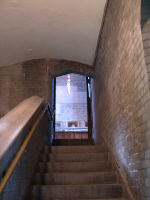
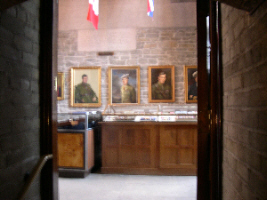
Return to start of Virtual Tour
The Memorial Window
 The dramatic feature on entering The Memorial Room is the great stained glass window commissioned for Soldiers’ Tower and dedicated November 6, 1995.
The dramatic feature on entering The Memorial Room is the great stained glass window commissioned for Soldiers’ Tower and dedicated November 6, 1995.
Designed and installed by The Russell C. Goodman Stained Glass Studios, of Parry Sound, its symbolism is based largely on John McCrae’s “In Flander’s Fields". The Victory Torch in the centre stands for the attainment of peace and of hope. The Maple Leaf, rising out of the flames, represents the emergence of Canada as a nation devoted to freedom, understanding and world peace. The poppies at the foot of the crosses invoke remembrance. The images in the four lower panels depict the men and women of the services: a sailor, a soldier, an airman, and a nurse. Across the bottom are written the words “Service Sacrifice Peace Freedom.”
Description and Symbolism
In the middle of the window we can see the Victory Torch standing for the attainment of peace and of hope. The Maple Leaf, rising out of the flames, represents the emergence of Canada as a nation devoted to freedom, understanding and world peace. The sun and light that radiates from it represent God.
At the top in the tracery observe the Coat of Arms of Canada and the Coat of Arms of the University of Toronto. The rest of the tracery forms are a series of blue colours representing the heavens: blue stands for truth; it is the colour of clear sky and of water, and a symbol of purity.
The rest of the tracery forms are a series of blue colours representing the heavens: blue stands for truth; it is the colour of clear sky and of water, and a symbol of purity.
Four upper panels: The sun, moon and stars represent creation, while the dove is the symbol for the Holy Spirit, and stands for purity and peace. Recalling the story of the flood, when Noah sent out the dove from the ark, it returned bearing an olive branch to show that the waters had receded and that God had made peace (forgiveness) with man. The clouds in the heavens are the natural veil of the blue sky and are, therefore, used as the symbol of the unseen God.
Four middle panels: In the centre, the Victory Torch, a symbol for the active attainment of peace and of hope, harks to the words of John McCrae. At the same time it reminds us of the commitment of the Canadian people at home who played their part in helping win the war. The perspective convergence of the crosses into the Torch represents the collective sacrifice and unity of the Armed Forces to achieve Victory. In the outer files are seen representation of the stones that replaced the earlier temporary wooden markers. The poppies at the foot of the markers invoke remembrance, while the purple hills in the distance recall Vimy Ridge and World War I. The different greens of Flanders Fields are the colours of spring symbolizing the triumph of spring over winter, or of life over death, and represent hope. Meadowlarks, which fly high and sing only when in flight toward heaven, represent the souls of the dead.
The images in the four lower panels depict the men and women of the services: the sailor taking a sextant sight represents the need for self-appraisal in changing times; the soldier, doing reconnaissance, represents the need for vigilance and foresight; the airman, preparing to take off, represents the need for dedication and trust of others to accomplish common goals. In the nurse we see compassion and concern for all humanity, a consciousness of which we must never lose sight.
Across the bottom are written the words:
Service ~ Sacrifice ~ Peace ~ Freedom
The Poppy
How did the poppy become the symbol of remembrance?
Poppy seeds live a very long time and will remain dormant under the soil for up to 80 years. Any disturbance that scuffles sleeping seeds back up to the surface of the soil will break their dormancy and result in a burst of flowers. This is what happened in Flanders during World War One when bombs completely destroyed the existing vegetation and at the same time stirred up millions of poppy seeds. The spectacular result was millions of wild poppies turning the landscape red.
When John McCrae from Guelph admired the spectacle of colour he was moved write In Flanders Fields. McCrae used the Victorian botanical term blow which meant "to flower." The term has confused people ever since. It would have been less confusing but perhaps less poetic to write grow to rhyme with row on row. A pervasive urban myth developed recently when the Canadian Mint produced the new ten dollar bill. The first few lines of the McCrae poem grace the bill. People felt that the word blow was a misprint. The story got around that the bills were being recalled and any still in circulation with the offending word were worth up to $270. Dr. McCrae would likely have had a good chuckle over that one.
The Artists
The Memorial Window and the eight new windows along the staircase were designed by: Christopher Goodman and Angela Zissoff of Goodman Zissoff Stained Glass Studios, Kelowna, BC, formerly the Russell C. Goodman Stained Glass Studio.
The Russell C. Goodman Stained Glass Studio, founded approximately fifty years ago, has created church windows across Canada and executed numerous secular pieces for private residence and government commissions, including the Armed Forces in Nova Scotia and the House of Commons, Parliament Buildings in Ottawa. Commissions also include one of the largest stained glass windows in Canada, located at St. Patrick's Cathedral in Thunder Bay.
Goodman Glass is known for its blend of modern and traditional styles and enjoyed for its wealth of colour. To achieve the beauty of their windows, they are committed to incorporating the finest hand blown antique glass from around the world and the highest quality craftsmanship from designing to fabrication, to final installation.
Russell C. Goodman, C.M., founded the studio and in time it grew into a family guild that has employed the collective talents of his wife and three sons, all of whom have participated actively in the many commissions that have been awarded them. In 1989 Russell Goodman was invested with The Order of Canada in honour of the exemplary merit and achievement he has shown as a stained glass designer and artist. In addition, in 2001, Mr. Goodman also received the Govenor General's Award.
Chris Goodman graduated from the Ontario College of Art, Toronto in 1980 and has been making stained glass for 37 years. Angela Zissoff studied graphic design and printmaking at George Brown College, Toronto and Fine Arts at U of T. Shortly after Angela met and married Chris she became involved with stained glass and has been doing so for 17 years. Until 2004, Chris and Angela have been operating within the province of Ontario. They recently moved to Kelowna, BC.
The windows in the University of Toronto Soldiers' Tower are the work of Christopher Goodman and his wife Angela Zissoff.
Return to start of Virtual Tour
The West Wall
"Great Canadians in Peace and War"
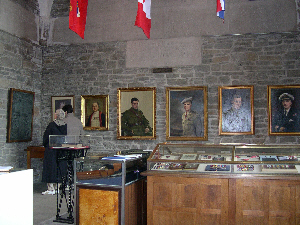 On the West Wall are portraits of a few illustrious graduates of this University:
On the West Wall are portraits of a few illustrious graduates of this University:
Lt-Col John McCrae
Nursing Sister Harriet Tremaine Meiklejohn
Major Thain MacDowell. VC, DSO
Major Fred Tilston VC
Sir Frederick Banting
Dr. Charles H. Best
Lt-Col John McCrae
 A sculptured plaque depicting a field of poppies supporting a cross and inscribed with his immortal poem "In Flanders Fields" is on the south wall. From this University he received three degrees: BA, 1894; MB, 1898; MD, 1910. His military life encompassed distinguished service in the South African War and the First World War.
A sculptured plaque depicting a field of poppies supporting a cross and inscribed with his immortal poem "In Flanders Fields" is on the south wall. From this University he received three degrees: BA, 1894; MB, 1898; MD, 1910. His military life encompassed distinguished service in the South African War and the First World War.
Dr. Charles H. Best.
Lieutenant-Colonel John McCrae, 1872-1918, studied at University College and in the Faculty of Medicine at the University of Toronto: B. A. 1894; M.B. 1898; M.D. 1910.
IN FLANDERS FIELDSIn Flanders fields the poppies blowBetween the crosses, row on row,That mark our place; and in the skyThe larks, still bravely singing, flyScarce heard amid the guns below.We are the Dead. Short days agoWe lived, felt dawn, saw sunset glow,Loved, and were loved, and now we lieIn Flanders fields.Take up our quarrel with the foe:To you from failing hands we throwThe torch; be yours to hold it high.If ye break faith with us who dieWe shall not sleep, though poppies growIn Flanders fields.John McCrae (1915)
Nursing Sister Harriet Tremaine Meiklejohn
 Known for her professionalism and discipline, the legendary Miss Harriet T. Meiklejohn, is frequently mentioned as an inspiration to many nurses who worked at Women's College Hospital prior to the Second World War. She imbued all of her staff with a deep pride in their vocation. When she retired, the alumni set up a scholarship in her name for postgraduate training.
Known for her professionalism and discipline, the legendary Miss Harriet T. Meiklejohn, is frequently mentioned as an inspiration to many nurses who worked at Women's College Hospital prior to the Second World War. She imbued all of her staff with a deep pride in their vocation. When she retired, the alumni set up a scholarship in her name for postgraduate training.
After graduating from McGill University with a BA in 1903, she trained at the Presbyterian Hospital, New York, graduating in 1906, and worked for a few years in the USA. During World War I, she served overseas as a Nursing Sister. She made the trip at her own expense, and was attached to the Canadian Medical Corps in France. She was awarded the Royal Red Cross for distinguished service. She returned to Canada in 1919 and took postgraduate work in Public Health Nursing at the University of Toronto, completing the course in 1921. She was employed for a while in Public Health Nursing in both Ontario and New Brunswick. Miss Meiklejohn served as Superintendent of Women's College Hospital from 1927 to 1943.
This portrait of Miss Meiklejohn is on loan from the Miss Margaret Robins Archives of Women's College Hospital.
Major Thain MacDowell. VC, DSO
 Earned the Victoria Cross in the Battle of Vimy Ridge on Easter Monday 1917 when he captured 77 enemy and two machine guns, one of which is also on display in the room (Maxim 1916). Alongside is an excerpt from his VC citation. He had previously won the Distinguished Service Order at the battle of the Somme 1916. A graduate of Victoria College, he received the degree of Master of Arts (honoris causa) from the University on November 11th, 1919, when the cornerstone of the Tower was laid. For the wording of his citation, click the link. Some more information about Major MacDowell, including his picture and comment from Torontonensis 1914, a biography by his grand-nephew, Charles Dumbrille, a picture of him receiving the Victoria Cross from George V and the text of three dispatches he sent to his battalion commander during the Battle of Vimy Ridge has been added.
Earned the Victoria Cross in the Battle of Vimy Ridge on Easter Monday 1917 when he captured 77 enemy and two machine guns, one of which is also on display in the room (Maxim 1916). Alongside is an excerpt from his VC citation. He had previously won the Distinguished Service Order at the battle of the Somme 1916. A graduate of Victoria College, he received the degree of Master of Arts (honoris causa) from the University on November 11th, 1919, when the cornerstone of the Tower was laid. For the wording of his citation, click the link. Some more information about Major MacDowell, including his picture and comment from Torontonensis 1914, a biography by his grand-nephew, Charles Dumbrille, a picture of him receiving the Victoria Cross from George V and the text of three dispatches he sent to his battalion commander during the Battle of Vimy Ridge has been added.
Major Fred Tilston VC
 Awarded the Victoria Cross for his persistent courage and outstanding leadership, despite serious wounds, in the critical battle to clear the Hochwald Forest (Germany), March 1, 1945. With the Company reduced to one quarter strength and the enemy repeatedly counterattacking, Major Tilston moved in the open, organizing defence and inspiring his men to hold firm against great odds. He repeatedly crossed ground dominated by intense fire from enemy machine-gun posts to carry ammunition to his troops. For the wording of his citation, click the link.
Awarded the Victoria Cross for his persistent courage and outstanding leadership, despite serious wounds, in the critical battle to clear the Hochwald Forest (Germany), March 1, 1945. With the Company reduced to one quarter strength and the enemy repeatedly counterattacking, Major Tilston moved in the open, organizing defence and inspiring his men to hold firm against great odds. He repeatedly crossed ground dominated by intense fire from enemy machine-gun posts to carry ammunition to his troops. For the wording of his citation, click the link.
A graduate in Pharmacy from the University of Toronto in 1929, he entered business and became sales manager of the Bayer Company by 1936. He enlisted in 1939, went overseas in 1941, and landed in Normandy soon after D Day. After the war, he rose to become President, and CEO of Sterling Drugs Ltd. By overcoming the loss of both legs and an eye he became an inspiration to young and old.
Sir Frederick Banting
 Banting was thirty-one in 1923 when he received the Nobel Prize for Medicine along with J. J. R. Macleod, Charles Best, and J. B. Collip. After service as a doctor in Flanders in The Great War, he tried general practice in London, Ontario, without much satisfaction; however, he was intrigued by the relationship between the pancreas and diabetes. His consequent experiments at the University of Toronto led to the discovery of insulin and an effective method of controlling diabetes. Fishing and painting were two outside activities he enjoyed. Some of his happiest times were on sketching trips with A. Y. Jackson. An intensely patriotic man, when the Second World War came, Banting threw himself into war work, and was on his way to England on a secret mission when he was killed in 1941 in a plane crash in Newfoundland.
Banting was thirty-one in 1923 when he received the Nobel Prize for Medicine along with J. J. R. Macleod, Charles Best, and J. B. Collip. After service as a doctor in Flanders in The Great War, he tried general practice in London, Ontario, without much satisfaction; however, he was intrigued by the relationship between the pancreas and diabetes. His consequent experiments at the University of Toronto led to the discovery of insulin and an effective method of controlling diabetes. Fishing and painting were two outside activities he enjoyed. Some of his happiest times were on sketching trips with A. Y. Jackson. An intensely patriotic man, when the Second World War came, Banting threw himself into war work, and was on his way to England on a secret mission when he was killed in 1941 in a plane crash in Newfoundland.
Dr. Charles H. Best
 Known for his work alongside Sir Frederick Banting in the discovery of insulin. He was however Professor of Physiology and famed for much other medical research. The discoveries of histaminase, the vitamin cholene, the effect of heparin in preventing thrombosis and numerous purifications of insulin improved knowledge of its effects and uses are among his accomplishments. In the Second World War, he developed many applications for the armed services.
Known for his work alongside Sir Frederick Banting in the discovery of insulin. He was however Professor of Physiology and famed for much other medical research. The discoveries of histaminase, the vitamin cholene, the effect of heparin in preventing thrombosis and numerous purifications of insulin improved knowledge of its effects and uses are among his accomplishments. In the Second World War, he developed many applications for the armed services.
The portraits of Banting, Best and Tilston on the west wall were painted by Brenda Bury, an outstanding contemporary portrait artist. The picture of Nursing Sister Meiklejohn is on loan from the Women's College Hospital Foundation.
Adjacent to the West Wall in a position of Honour is a portrait of our gracious sovereign Queen Elizabeth II. 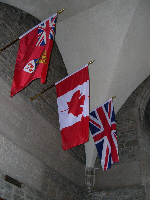 The quiet courage of her parents, her sister and herself during the dark days of the Battle of Britain helped keep up the morale and determination of the defenders of our way of life in Britain and throughout the world.
The quiet courage of her parents, her sister and herself during the dark days of the Battle of Britain helped keep up the morale and determination of the defenders of our way of life in Britain and throughout the world.
Above these pictures hang the Canadian Red Ensign, the National Flag of Canada, and the Union Flag (often called “Union Jack”) which is the royal flag in Canada. The first, in varying versions, was used as the civil flag of Canada from the nineteenth century, the international symbol from 1924, and the national flag from 1945 to 1965.
High on the stone walls are inscribed blocks stating the number and dedication of carillon bells. More on the dedication of the bells.
Return to start of Virtual Tour
East Wall, "U of T during the Wars"
The East Side Features on & off Campus activity during the Wars
 The Naval Officer’s Association of Canada, Toronto Branch, presented the bronze plaque on the north-east wall listing thirty-one ships of the Royal Canadian Navy which were lost at sea in the Second World War. This poignant memorial was dedicated on November 11th, 1985. Other plaques record significant themes or donations, including one from the surviving members of the 67th (Varsity) Battery on their sixtieth anniversary.
The Naval Officer’s Association of Canada, Toronto Branch, presented the bronze plaque on the north-east wall listing thirty-one ships of the Royal Canadian Navy which were lost at sea in the Second World War. This poignant memorial was dedicated on November 11th, 1985. Other plaques record significant themes or donations, including one from the surviving members of the 67th (Varsity) Battery on their sixtieth anniversary.
Among the photographs on this wall is one of the SPS Junior Rugby team, winners of the Mulock Cup in 1915. Every member of this team joined up in 1916 and not all returned. It was donated by H.R. Burton,  a member of the team, who drew the crosses marking those friends who did not return. “Bob” Burton, a veteran of both world wars, was Chief Traffic Engineer for the City of Toronto for many years. Among his many accomplishments was the development of this City’s traffic control computer. He died in 1997 at the age of 101.
a member of the team, who drew the crosses marking those friends who did not return. “Bob” Burton, a veteran of both world wars, was Chief Traffic Engineer for the City of Toronto for many years. Among his many accomplishments was the development of this City’s traffic control computer. He died in 1997 at the age of 101.
Other photographs on the east wall include ones of the University of Toronto Contingent, Canadian Officers Training Corps (COTC), of Remembrance Day 1942 and of the 67th (Varsity) Battery. One may recognize many prominent graduates in these photographs. The U of T COTC, organized in November 1914, trained thousands of officers for the armed services in two world wars and in peacetime. The 67th (Varsity) Battery, Canadian Field Artillery was recruited on this campus in 1916. After the war, members of this unit formed the 67th Battery Association, which met monthly for lunch, and held annual reunions at their fishing camp on Sturgeon Lake for many years. This Association provided the two oaken benches in the Memorial Room and the handrail on the stairwell.

The Propeller on this wall is from an Avro Anson. These planes were used for training pilots and other aircrew in the British Commonwealth Air Training Plan, which was a major Canadian contribution to the war effort. It involved the creation in Canada of an enormous training organization, including at its peak 97 flying schools and 184 other units. By March 31, 1945, when it was closed down, the plan had produced 131,553 aircrew personnel for the Commonwealth countries, a tremendous contribution to victory. Many U. of T. men took part in this training.
Colonel W. R. Lang VD
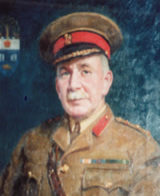 The first Commanding Officer of the University of Toronto Contingent COTC. He commanded it during and after the First World War (1914-1925) and later became the first Director of Military Studies at this University. He was appointed to The Canadian General Staff in 1914 and among other responsibilities was in charge of Coast Defence in the Maritimes in 1918. Before the war he was a professor of Chemistry at this University. He was president of the Canadian Operatic Society.
The first Commanding Officer of the University of Toronto Contingent COTC. He commanded it during and after the First World War (1914-1925) and later became the first Director of Military Studies at this University. He was appointed to The Canadian General Staff in 1914 and among other responsibilities was in charge of Coast Defence in the Maritimes in 1918. Before the war he was a professor of Chemistry at this University. He was president of the Canadian Operatic Society.
Lt-Col H.H. Madill OBE VD
 Commanded the COTC (1935-1945) before and throughout the Second World War. He taught at the this University’s School of Architecture from 1912 to 1957, was Director from 1934 to 1957. From 1915 to 1919 he was the Officer in charge of training for the Polish Army in Canada. He was a partner in the architectural firm of Craig & Madill.
Commanded the COTC (1935-1945) before and throughout the Second World War. He taught at the this University’s School of Architecture from 1912 to 1957, was Director from 1934 to 1957. From 1915 to 1919 he was the Officer in charge of training for the Polish Army in Canada. He was a partner in the architectural firm of Craig & Madill.
The portraits of Lang & Madill on this wall were painted by two of Canada’s foremost artists, Wylie Greer and Charles Comfort.
 The King’s Colour of The 2nd Canadian Pioneer Battalion is displayed on the south-east wall in a specially-designed case to preserve it for future generations and to allow close inspection of its design. Normally such colours are laid up in churches, but this battalion of the First World War presented its King’s Colour to the University because the majority of its officers were graduates of the Faculty of Applied Science and Engineering. Having suffered the ravages of time, the colour was restored, by many months of patient needlework, and encased by the Canadian Conservation Institute, Ottawa (c. 1980). This Battalion performed military engineering duties in or near the front lines under harassment by rifle fire, machine guns, high explosive shells, mines, aerial bombs, booby traps, several gas attacks, and other constant dangers of trench warfare. It took part in battles such as the Somme, Courcellette, St. Eloi, Vimy Ridge, Lens, Hill 70, Ypres and Passchendaele. It had an establishment of 35 officers and almost 1000 other ranks, mainly skilled tradesmen or men used to bush life in Canada. Its casualties were over 120 killed in action or died of wounds, 7 missing and 546 wounded.
The King’s Colour of The 2nd Canadian Pioneer Battalion is displayed on the south-east wall in a specially-designed case to preserve it for future generations and to allow close inspection of its design. Normally such colours are laid up in churches, but this battalion of the First World War presented its King’s Colour to the University because the majority of its officers were graduates of the Faculty of Applied Science and Engineering. Having suffered the ravages of time, the colour was restored, by many months of patient needlework, and encased by the Canadian Conservation Institute, Ottawa (c. 1980). This Battalion performed military engineering duties in or near the front lines under harassment by rifle fire, machine guns, high explosive shells, mines, aerial bombs, booby traps, several gas attacks, and other constant dangers of trench warfare. It took part in battles such as the Somme, Courcellette, St. Eloi, Vimy Ridge, Lens, Hill 70, Ypres and Passchendaele. It had an establishment of 35 officers and almost 1000 other ranks, mainly skilled tradesmen or men used to bush life in Canada. Its casualties were over 120 killed in action or died of wounds, 7 missing and 546 wounded.
 Overhead hang the Royal Canadian Navy ensign, the flag of the United Nations and the Royal Canadian Air Force ensign. The Navy, Air Force, & Red ensigns recognize Canada’s Armed Forces. The UN flag is included to recognize Canada’s peacekeeping endeavours.
Overhead hang the Royal Canadian Navy ensign, the flag of the United Nations and the Royal Canadian Air Force ensign. The Navy, Air Force, & Red ensigns recognize Canada’s Armed Forces. The UN flag is included to recognize Canada’s peacekeeping endeavours.
High on the stone walls the blocks inscribed with the number and dedication of carillon bells continue (XII to XXIII). More on the dedication of the bells.
Return to start of Virtual Tour
The Medal Cabinet
 The display case in the north central floor houses an extensive collection of decorations and medals. The medals on the left (east) side, are examples of services medals presented to veterans of wars and campaigns, including the Great War, Second World War and Korean War. On the right (west) side, are individual medals and sets of medals donated by the recipients or their families.
The display case in the north central floor houses an extensive collection of decorations and medals. The medals on the left (east) side, are examples of services medals presented to veterans of wars and campaigns, including the Great War, Second World War and Korean War. On the right (west) side, are individual medals and sets of medals donated by the recipients or their families.



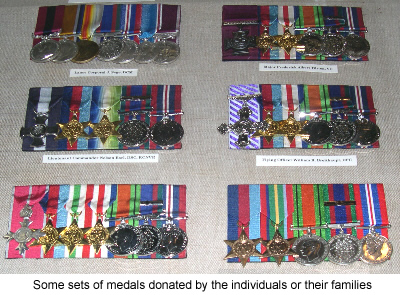

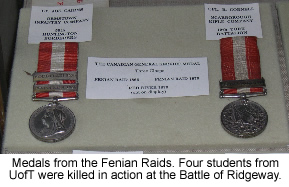
Two examples of donated sets of medals are shown below. The University was given the medals of Major Thain MacDowell, VC, but they are not on display. For security reasons they are in safekeeping elsewhere. We have placed replicas of Major Fred Tilston's medals in the cabinet.
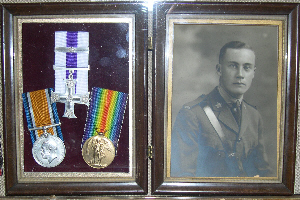 Alexander Watson Baird was born in Toronto, March 2, 1892 and died in action in Flanders, Aug. 8, 1918. He was a Captain with the One-hundred-and-sixteenth Battalion. He was educated at Church Street Public School in Toronto, Upper Canada College and University College (1910-11) and a member of Beta Theta Pi fraternity. He was employed by Kent, McClain Co. and a Lieutenant in the 40th Regiment.
Alexander Watson Baird was born in Toronto, March 2, 1892 and died in action in Flanders, Aug. 8, 1918. He was a Captain with the One-hundred-and-sixteenth Battalion. He was educated at Church Street Public School in Toronto, Upper Canada College and University College (1910-11) and a member of Beta Theta Pi fraternity. He was employed by Kent, McClain Co. and a Lieutenant in the 40th Regiment.
The Memorial Book "Roll of Service 1914-1918" tells us that: “He was first appointed to the 80th Battalion and later transferred to the 126th. After reaching England in August 1916, he joined the 116th Battalion and went with it to France in February 1917. In that year he served through the battles of Vimy, Hill 70, and Passchendaele. In the latter engagement he won the Military Cross for his bravery and skill in leading a successful raid on the enemy's trenches prior to the battalion's attack. On April 1-2, 1918, he won a Bar to the Cross for his service in a trench raid at Mericourt on the Lens front. On the first day of the battle of Amiens the battalion in advancing on Hamon Wood suffered severe casualties from machine gun fire. Leading his company he at once attacked a machine gun nest. Though he was hit several times he captured the position, but was shot by a concealed officer as the enemy were surrendering. His prompt action saved many lives and enabled the battalion to advance. Buried at Hourges.”
 James Gordon Beatty received his Military Cross for his conduct at Passchendaele in November 6 1917. He was born in 1894 in the town of Brampton, Ontario, and spent his early years there. In 1910 he entered the University of Toronto, University College, to study Mathematics and Physics. He received both a BA(1914) and a MA(1915).
James Gordon Beatty received his Military Cross for his conduct at Passchendaele in November 6 1917. He was born in 1894 in the town of Brampton, Ontario, and spent his early years there. In 1910 he entered the University of Toronto, University College, to study Mathematics and Physics. He received both a BA(1914) and a MA(1915).
In 1915 he joined the 2nd Divisional Cyclists Corps as a Private and, following a short time in England, his unit was sent to France, where their duties included dispatch riding, trench guiding, and working parties of all kinds. He took part in the battle of the Somme, and in mid 1916 applied for a commission in the Artillery, which he received in spring of 1917. He was posted to the 5th Battalion Canadian Field Artillery to take part in the battle of Vimy Ridge. Later that year this Battery took part in the battle of Passchendaele, a different kind of battle, where he was assigned to a front line observation post. He was awarded the Military Cross for his part in that action.
Following the war he returned to Toronto, and in 1919 joined Canada Life Assurance Company as an actuarial student. He stayed with that company for the rest of his working life, seventy-one years, rising to Vice-President and Chief Actuary in 1949. On retirement, he was appointed a member of the Board and Vice-President. In 1969 he retired from the Board, and in 1978 became archivist of the Company. In 1986 a Scholarship in Gordon Beatty's name for students in Mathematics was established at the University of Toronto.
J. Gordon Beatty died in Toronto on November 25, 1990 in his 97th year. He bequeathed his medals to Hart House, which loaned them to the University of Toronto Alumni Association for display here in the Memorial Room.
The University and the Alumni want to remember with gratitude the large number of volunteers from this University who paid the supreme sacrifice in two world wars. They had many motives for volunteering, but all were willing to give up their lives for that which they valued more than life itself.
Return to start of Virtual Tour
The Memorial Books
Resting on a metal pedestal in the centre of the Memorial Room are the University of Toronto “Roll of Service 1914-1918” and the “Memorial Book for 1939-1945.”
The Roll of Service 1914-1918’s introduction outlines the role of the University during the First World War. The Chapter, “Roll of Honour” contains detailed records of staff members, graduates and undergraduates who died while on Active Service. “Roll of Honour II” lists those disabled who died soon after discharge. The “Roll of Service” (pages 167-527) states in abbreviated form the records of those who returned safely. This is followed by a statistical summary of services and honours and the records of veterans who first registered in the University after returning from Active Service. In all, over 6,000 names are recorded.
graduates and undergraduates who died while on Active Service. “Roll of Honour II” lists those disabled who died soon after discharge. The “Roll of Service” (pages 167-527) states in abbreviated form the records of those who returned safely. This is followed by a statistical summary of services and honours and the records of veterans who first registered in the University after returning from Active Service. In all, over 6,000 names are recorded.
Under this book in the Photo, may be seen, bound in red, a similar book for Trinity College.
In order to honour the students, staff and alumni of this University who gave their lives in the service of Canada in the Second World War, 1939-45, the Soldiers’ Tower Committee of the UTAA published the University of Toronto Memorial Book 1939 to 1945 in 1994. This 84 page book lists the names of the 557 former students, graduates, faculty and staff of the University lost in that conflict. Each listing includes faculty, time spent at the University, degrees earned, rank, honours, and places of death and burial. Also included are pictures of 67 of these honoured dead, donated by relatives and friends. Desmond Morton wrote the preface.
Return to start of Virtual Tour
Other Displays
Other cases contain a soldier’s cap, a chaplain’s tippet, two communion chalices, a soldier’s testament, a military bugle, spurs, an air-raid warden’s helmet, W.W.II combat helmet, identity discs, buttons, badges, a pass from Fort Niagara, W.W.I era German hat and helmet that were souvenirs collected by the 67th Battery Association as well as other mementoes of service and books related to Canada’s war effort.


Return to start of Virtual Tour
The Soldiers' Tower at Ground Level
Return to start of Virtual Tour